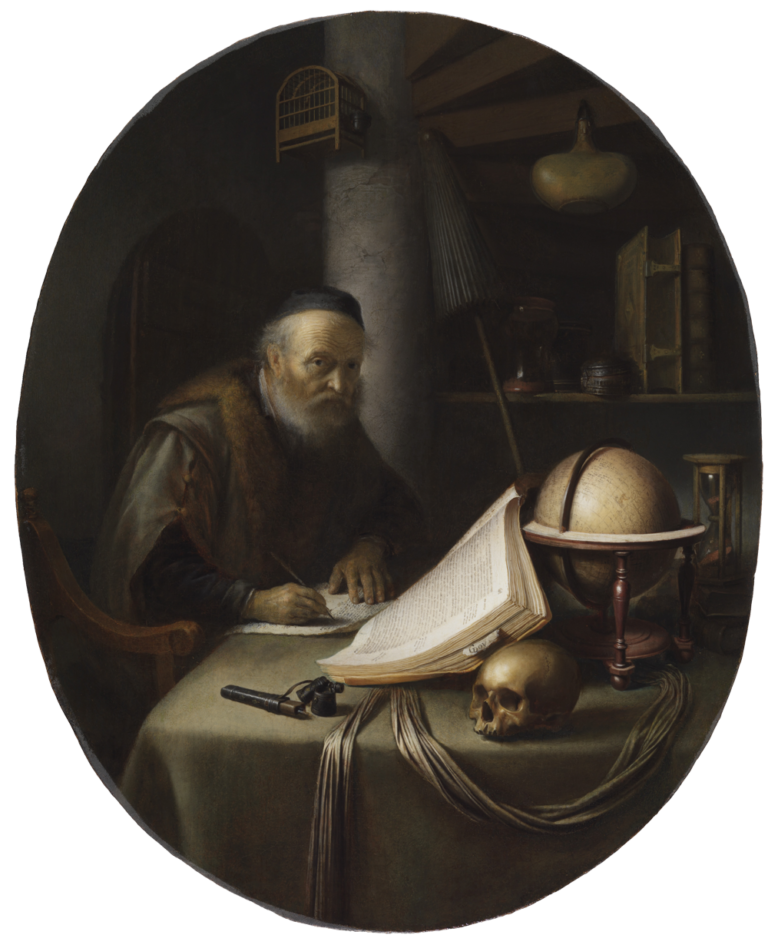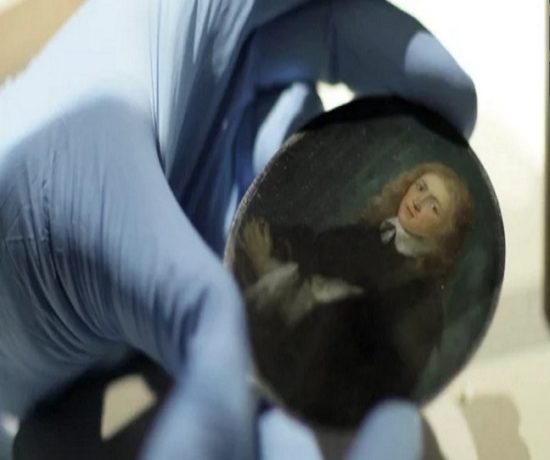An elderly scholar glances up from his writing to gaze directly at the viewer. With pen paused on the paper before him, he sits at his desk where an open book leans against a globe and a pen case lies obliquely along the table edge. Among Gerrit Dou’s numerous paintings of a scholar in his study, none focuses so directly on a specific moment in time as does this compelling masterpiece, one of the most finely accomplished works in the artist’s early mature style. The old man’s alert pose and fleeting expression create the sense of an arrested moment, whereas Dou’s careful rendering of the scholar’s aging features, including his thinning hair and finely wrinkled skin, reveals a keen awareness of time’s inevitable passing. The artist reiterates this emphasis by depicting an hourglass with fine sand trickling through its narrow neck.
Dou concentrates our attention on the scholar’s expression through a delicate play of light and shadow on his face. Light flooding in from the left highlights his forehead and the tip of his nose, leaving his eyes dimly lit in shadow. This focus is heightened by the glowing light on the column, which contrasts with the shadow on the man’s face and the darkness of the background. The open book casts a subtle reflection of light back onto his face, seeming to embody the way its contents illuminate him and further reinforcing the psychological intensity of his gaze.
Dou’s mastery of lighting and compositional balance in Scholar Interrupted suggests that he executed this work around 1635. Another point of reference for this date, as Baer has noted, is the close compositional similarity between this work and Rembrandt’s etched Portrait of Johannes Wtenbogaert, dated 1635.1 The painting also shares much in common with another small-scale panel from 1637, Dou’s earliest extant dated work, An Interior with a Young Violinist in Edinburgh (fig 1). In both paintings, Dou creates an effective balance between a single figure in an interior space and copious still-life elements surrounding him. Many of the objects on the table and shelves in Scholar Interrupted, particularly the terrestrial globe and the book with the metal clasp, reappear in Dou’s other paintings from this period. His muted palette, dominated by browns, grays, and tawny yellows for the highlights, is also seen in other works from this period such as his Self-Portrait in Cheltenham and Portrait of a Lady, Seated with a Music Book on Her Lap in the present collection (GD-116).
Martin identified the model for the scholar as Douwe Janszoon, the artist’s father.2 Dou’s father, however, would have been about fifty years old in 1635, and the scholar in this painting appears significantly older than that.3 The bearded old man wears a tabbaard, a traditional housecoat commonly worn in the seventeenth century by lawyers, scholars, and ecclesiastics. His black skullcap probably indicates that Dou intended him as a religious scholar.4 Although the book on the table is visibly open to page 61 and contains chapter heads set off in the margins, its precise contents are illegible. The handwriting of the scholar’s letter is similarly blurred, yet Dou took great measures to distinguish the textual character of the book and letter by varying his brushwork.
An X-radiograph of the Scholar Interrupted reveals that the composition evolved during the painting process (fig 2). In the upper right quadrant, Dou originally planned for an artist’s easel similar to those that appear in his paintings from the late 1620s and early 1630s.5 This earlier configuration is seen in such works as Artist in His Studio (fig 3) and Man Writing by an Easel (fig 4), which point to the concept of the learned artist or the parallel between the artist and the scholar.6 When he painted over the easel in the present work, he added a shelf with various small jars and books and included a Japanese parasol leaning against the wall. While the compositional reworking does not appear to be unusual for Dou, the change signifies a development in the fine-tuning of the iconography.7
The pictorial tradition of the scholar in his study was especially popular in Leiden among Rembrandt van Rijn (1606–69) and his followers in the decade between about 1625 and 1635.8 Given that the city was an important center of scholastic learning, the seat of one of the oldest universities in Europe, and the site of a prominent school of theology, the painting’s subject matter and themes would have been familiar to the local intellectual elite. Though the painting possesses the character of a genre scene painted from life, the nature of the scholar’s contemplative work is evoked in the various symbolic references associated with the still-life objects. The books and terrestrial globe may be understood as attributes of the scholar’s wisdom and knowledge, while the hourglass and skull were well-established vanitas symbols that refer to the passing of time and the fleeting nature of existence. One can assume that the scholar himself is examining questions about the transience of life in his own writings, and that he remains mindful that the wisdom and knowledge passed along through books will long outlive him. As a clever parallel, Dou references the theme of art surpassing the artist’s short life by inserting his signature, “GDou,” on a tattered piece of paper on the side of the book, adjacent to the skull.9
The precise meanings of the objects on the shelf—particularly the closed Japanese parasol, the empty birdcage, and the gourd hanging from the staircase—are more difficult to establish.10 The parasol frequently appears in Dou’s later paintings, whether in his self-portraits above his easel or as an attribute of a quack performing before gullible listeners.11 In both contexts, the open parasol appears to signify the working of illusion through deception.12 Another intriguing detail is the barely visible metal container on the shelf nestled between two jars above the globe, on which Dou has written the letters “[…]ALVES” (fig 5).13 This ambiguous reference may, in fact, allude to salves and identify its contents as ointments, an indication of the practice, often associated with quacks, of using herbal remedies in the treatment of physical ailments.14 It is difficult to pinpoint the precise meaning of these elements and in what manner Dou intended for them to relate, if at all, to the scholar’s work of contemplation and writing.
Three known much later versions and an engraving from around 1760 by Nicolas Joseph Voyez (fig 6) correspond compositionally to the Scholar Interrupted, yet the painted versions may have been modeled after another now lost variant. They all differ from the present work in their arched-top rather than oval format, and only the Voyez print includes the scarf draped over the table edge and reflects the precise position of the pen case on the table as it appears in Scholar Interrupted.15 The lightly colored ground of the present work, visible along the entire circumference of the panel’s edge, rules out any possibility that the format was modified.
The year Dou executed the present work also marks the beginning of the patronage of the artist by the Delft merchant-turned-statesman Pieter Spiering. Dou’s early biographer Joachim van Sandrart recounts that Spiering offered Dou a lucrative retainer fee in exchange for the right of first refusal of his works.16 It is unclear how long this agreement lasted, but Spiering must have amassed a superb collection of paintings directly from the artist over the years, including the present Scholar Interrupted. The painting is listed in a document dated 1652 involving a group of ten panels that Spiering had sent to Queen Christina of Sweden for sale by approval, sometime in the late 1640s.17 Even though Queen Christina did not purchase Scholar Interrupted, Spiering’s positive assessment has been shared by later collectors, most notably Charles Morrison, who acquired this small masterpiece around 1854. The painting remained in the Morrison family at Sudeley Castle until it was sold in 2007, at which time it was acquired by the present collector.

